The Coonley Chair was designed in 1907 by famed American architect and interior designer Frank Lloyd Wright and made specifically for the Avery Coonley House.
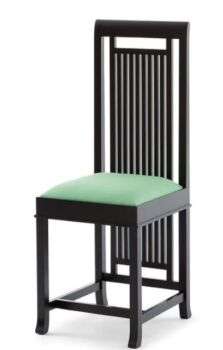
Image source: https://www.maclinstudio.com/products/frank-lloyd-wright-coonley-2-chair-wool-fabric-upholstery
The Chair
Harmony between the components that made up a building, both internal and external, was integral to Wright’s philosophy in creating a living space. Architecture, interiors, and furnishings, according to his vision, should all come from the same concepts and principles, which is an approach he defined “Organic Architecture.” Further, he believes everything had to be “of” the building itself and rejected the current American trends of historicist, premade furniture, or even those of his European Modernist peers, advocating for functional and standardized designs.
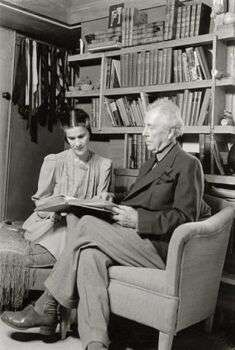
Image source: https://search.creativecommons.org/photos/656e2211-414f-47f3-8cfa-aed15b00bdbc by orionpozo
Especially in his earlier years, Wright was strongly influenced by the British Arts and Crafts movement, which combined traditional art and modern means of production. However, unlike them, he praised the strengths and potential shown by the machines. Thus allowed, to the point of often being rejected by most production firms, his incredibly innovative designs to come to fruition.
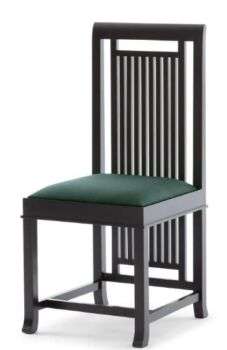
Despite lacking experience in woodworking, Wright created his furniture to accompany his building projects and started with his very Oak Park home. His goal was to reflect, through the use of simple, locally harvested oak wood, which showcased the democratic American ideals.
Following this vision, the Coonley Chair was designed to fit the Avery Coonley House.
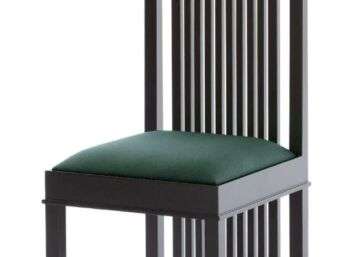
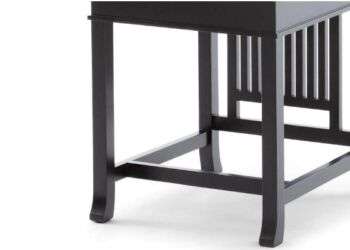
Images source: https://www.cassina.com/it/en/products/coonley-2.html
The chair’s appearance reflects Wright’s preoccupation in architecture and interior design alike. With geometric shapes and strong, intersecting planes, it is an architectonic piece of furniture. Additionally, architectural in its very character, it harmonizes the lines and materials used.
Throughout his life, Wright had a deep interest in the natural world, and the materials he chose for his furniture often reflected such interest. The Coonley Chair is not beyond this fascination. Its spare, geometric form being a counterpoint to the rich, long, flowing grain of the oak it is made out of, brings out its natural qualities, authenticity, and spacial harmony.
Avery Coonley House
As previously stated, Wright designed this chair for the Avery Coonley House, also known as the Coonley House, which wass series of several buildings forming a residential complex. In addition, between 1908 and 1912, the structure completed construction on the banks of the De Plane River in the historic Riverside, Illinois, a suburb of Chicago. Today, the house is a National Historic Landmark.

Image source: https://search.creativecommons.org/photos/7b4fb836-9966-4c4c-82fb-9a1a09998e4a by davidwilson1949

Image source: https://search.creativecommons.org/photos/07e216a6-4bd5-412b-b215-1935a415100d by Teemu008
Rich industrialists, Avery Coonley and his wife Queene Ferry, commissioned the project. The pair, after examining Wright’s body of work, told him they saw “the countenances of principle,” in his designs.
Coonley House exemplifies Wright’s Prairie style, with wide overhanging cornices, stripes of art glass windows, flowing interior spaces and a harmonious blend of space and structure, in and outdoors. This made it feel more like a small village than an insular home, with courtyards, buildings and garden walls acting as connective tissue. Further, the architect believed it to be among his finest works, and he designed down to the smallest feature, including rugs and textiles. Throughout the years, the house received numerous alterations and changes, at Wright’s hands or other successive architects’.
Materials
The Coonley chair’s back is natural cherrywood or walnut, either stained or black. Additionally, the seat cushions are polyurethane foam and upholstered with leather or fabric.
The chair is available in two versions: “Coonley 1” with a high backrest, or Coonley 2, with a low backrest.
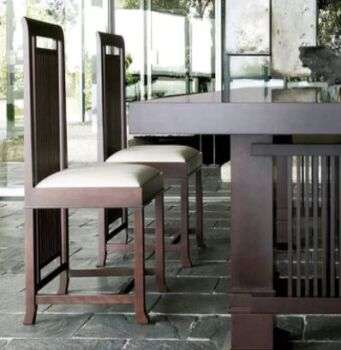
Image source: https://www.maclinstudio.com/products/frank-lloyd-wright-coonley-2-chair-wool-fabric-upholstery
Data Sheet
Coonley 1 Chair
43 x 47 cm
Height: 70 cm
Seat height: 46 cm
Coonley 2 Chair
43 x 47 cm
Height: 94 cm
Seat height: 46 cm
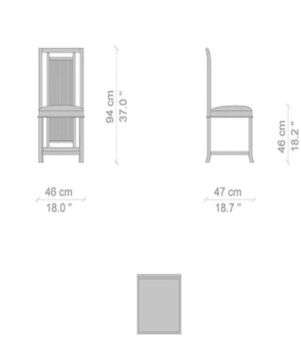
Image source: https://www.maclinstudio.com/products/frank-lloyd-wright-coonley-2-chair-wool-fabric-upholstery
Info sources:
For more references, please also visit: www.jbdesign.it
